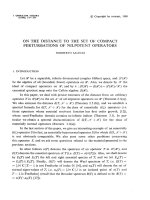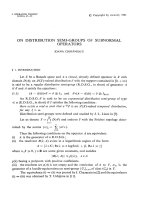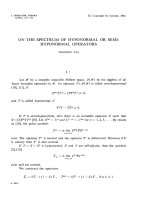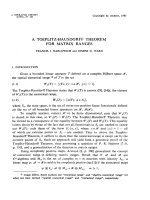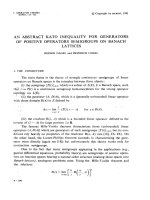Báo cáo toán học: " On plethysm conjectures of Stanley and Foulkes: the 2 × n case" ppsx
Bạn đang xem bản rút gọn của tài liệu. Xem và tải ngay bản đầy đủ của tài liệu tại đây (93.87 KB, 5 trang )
On plethysm conjectures of Stanley and Foulkes: the
2 × n case
Pavlo Pylyavskyy
Department of Mathematics
MIT, Massachusetts, USA
Submitted: Jul 5, 2004; Accepted: Oct 7, 2004; Published: Oct 18, 2004
Mathematics Subject Classifications: 05E10
Abstract
We prove Stanley’s plethysm conjecture for the 2×n case, which composed with
the work of Black and List provides another proof of Foulkes conjecture for the 2×n
case. We also show that the way Stanley formulated his conjecture, it is false in
general, and suggest an alternative formulation.
1 Introduction
Denote by V a finite-dimensional complex vector space, and by S
m
V its m-th symmetric
power. Foulkes in [4] conjectured that the GL(V )-module S
n
(S
m
V )containstheGL(V )-
module S
m
(S
n
V ) for n ≥ m.Form =2, 3 and 4 the conjecture was proved; see [7], [3],
[1]. An extensive list of references can be found in [8].
In [2] Black and List showed that Foulkes conjecture follows from the following com-
binatorial statement. Denote I
m,n
to be the set of dissections of {1, ,mn} into sets of
cardinality m.Lets =
n
i=1
S
i
and t =
m
i=1
T
i
be elements of I
m,n
and I
n,m
respectively.
Define matrix M
m,n
=(M
m,n
t,s
)by
M
m,n
t,s
=
1if|S
i
∩ T
j
| = 1 for any 1 ≤ i ≤ n, 1 ≤ j ≤ m;
0 otherwise.
Theorem 1.1 (Black, List 89). If the rank of M
m,n
is equal to |I
n,m
| for n ≥ m>1,
then Foulkes conjecture holds for all pairs of integers (n, r) such that 1 ≤ r ≤ m.
Let λ be a partition of N.Atableau is a filling of a Young diagram of shape λ with
numbers from 1 to N,andletT
λ
to be the set of such tableaux. Define two tableaux to
be h-equivalent, denoted ≡
h
, if they can be obtained one from the other by permuting
the electronic journal of combinatorics 11(2) (2004), #R8 1
Figure 1: A counterexample for Stanley’s conjecture.
elements in rows and permuting rows of equal length. Define a horizontal tableau to be an
element of H
λ
:= T
λ
/ ≡
h
. In other words, rows of a horizontal tableau form a partition
of the set {1, ,N}. Similarly, define v-equivalence ≡
v
and the set V
λ
:= T
λ
/ ≡
v
of
vertical tableaux of shape λ. Consider a horizontal tableau Γ with rows r
1
, ,r
p
and a
vertical tableau ∆ with columns c
1
, ,c
q
. Call Γ and ∆ orthogonal, denoted Γ ⊥ ∆, if
the inequality |r
i
∩ c
j
|≤1 holds for all i, j . Equivalently, Γ and ∆ are orthogonal if and
only if there exists a tableau ρ consistent with both Γ and ∆.
Define the matrix K
λ
=(K
Γ,∆
λ
)by
K
Γ,∆
λ
=
1ifΓ⊥ ∆;
0 otherwise.
The rows of K
λ
are naturally labelled by horizontal tableaux, while the columns are
labelled by vertical tableaux. Let λ
be the conjugate partition. In [6], Stanley formulated
a conjecture, which can be equivalently stated as follows.
Conjecture 1.2. If λ ≥ λ
in dominance order, i.e. λ
1
+ ···+ λ
i
≥ λ
1
+ ···+ λ
i
for all
i, then the rows of K
λ
are linearly independent.
This conjecture is false. For the shape λ shown in Figure 1, the inequality λ ≥ λ
holds. However, the matrix K
λ
has more rows than columns, thus the rows cannot be
linearly independent. Indeed, |H
λ
| =
12!
6!2!2!1!1!2!2!
, which is greater than |V
λ
| =
12!
5!3!1!1!1!1!4!
.
This counterexample was suggested by Richard Stanley as the smallest possible one.
The following conjecture seems to be a reasonable alternative formulation, although Max
Neunh¨offer has recently shown that in general approach of Black and List does not work,
see [5].
Conjecture 1.3. K
λ
has full rank for all λ.
Let m × n denote the rectangular shape with m rows and n columns. For rectangular
shapes, Stanley’s conjecture implies Foulkes conjecture since K
m × n
= M
m,n
. For hook
shaped λ, the conjecture is known to be true; see [6]. In Section 2 we present a proof of
Stanley’s conjecture for λ = 2 × n.
The author would like to thank Prof. Richard Stanley for the inspiration and many
helpful suggestions. The author is also grateful to Denis Chebikin for helping to make
this paper readable.
the electronic journal of combinatorics 11(2) (2004), #R8 2
1234
678910
1
10
7
2
9
4
3
6
5
8
7
2
5
8
123 45
678 910
µ =
µ =
⊥
⊥
ν =
ν
=
5
Figure 2: Partial tableau ∆
is a subtableau of ∆. Since Γ ⊥ ∆, also Γ ⊥ ∆
.
2 The Main Result
Our aim is to prove the following theorem.
Theorem 2.1. Conjecture 1.3 is true for λ = 2 × n.
Note that for rectangular shapes, Conjectures 1.2 and 1.3 are equivalent, because for
m ≤ n, the inequality |H
m × n
|≤|V
m × n
| holds. Therefore, proving that K
2 × n
has full rank is equivalent to proving that its rows are linearly independent. Suppose
for contradiction that there is a nontrivial linear combination of rows of K
2 × n
equal
to 0. Let τ
Γ
be the coefficient of the row corresponding to a horizontal tableau Γ in
this combination. Then for a column of K
2 × n
labelled by a vertical tableau ∆, the
linear combination
Γ
K
Γ,∆
2 × n
τ
Γ
equals 0. Alternatively, this sum can be written as
Γ⊥∆
τ
Γ
= 0. Call a 0-filter a condition on horizontal tableax such that sum of τ
Γ
over
all Γ satisfying this condition is 0. Thus, orthogonality to ∆ is a 0-filter. Our aim is to
show that being Γ is a 0-filter for every horizontal tableau Γ. Indeed, this is just saying
that all τ
Γ
are equal to 0, which contradicts the assumption above.
Definition 2.2. For k<n,asubtableau of shape 2 × k of a vertical tableau ∆ of shape
2 × n is a subset of k columns of ∆. A partial tableau is a collection of k columns which
is a subtableau of at least one vertical tableau ∆.
In other words, a partial tableau is a vertical tableau of shape 2 × k, filled with
numbers from {1, ,2n}. We can now generalize the concept of orthogonality as follows.
Call a horizontal tableau Γ of shape 2 × n orthogonal to a partial tableau ∆
of shape
2 × k,wherek<n, if there exists vertical tableau ∆ of shape 2 × n such that Γ ⊥ ∆,
and ∆
is a subtableau of ∆. An example is presented in Figure 2. The reason for
considering such a generalization is evident from the following theorem.
Theorem 2.3. Orthogonality to a certain partial tableau ∆
is a 0-filter.
Proof. For a given partial tableau ∆
of shape 2 × k,denote
F (∆
)={∆ ∈ V
2 × n
| ∆
is a subtableau of ∆}.
the electronic journal of combinatorics 11(2) (2004), #R8 3
n − kk n− kk
νν
µ ⊥ ν
Figure 3: Each matching corresponds to exactly one possible tableau ∆ ⊥ Γ containing
∆
as a subtableau.
Consider the sum
∆∈F (∆
)
Γ⊥∆
τ
Γ
. We claim that for each horizontal tableau Γ, τ
Γ
enters this sum with the same coefficient. Indeed, the coefficient of a particular τ
Γ
is the
number of tableaux ∆ containing ∆
and orthogonal to Γ. Such ∆’s are in one-to-one
correspondance with matchings between two sets of size n − k, as can be seen from the
Figure 3. The number of such matchings is (n − k)!, which obviously does not depend
on particular Γ. Therefore,
1
(n−k)!
∆∈F (∆
)
Γ⊥∆
τ
Γ
=
Γ⊥∆
τ
Γ
. Since each
Γ⊥∆
τ
Γ
is
zero by the assumption above, the sum
Γ⊥∆
τ
Γ
is also 0, which means that orthogonality
to ∆
is a 0-filter.
We now continue the proof of Theorem 2.1. Choose a particular horizontal tableau
Γ
0
, for example with one row filled with numbers 1, ,n and the other row filled with
the rest of the numbers. If we show that τ
Γ
0
= 0, then in a similar fashion (just by
relabelling numbers) we can show that all τ
Γ
’s are 0, which would be a contradiction
with the assumption that the combination of rows of K
2 × n
is nontrivial. For a given
horizontal tableau Γ, let a
Γ
and b
Γ
be the numbers of elements of {1, ,n} in the rows
of Γ, so that a
Γ
+ b
Γ
= n. We do not distinguish between the rows of Γ, therefore we
can assume that a
Γ
≥ b
Γ
.ObservethatΓ
0
is the only horizontal tableau such that
(a
Γ
0
,b
Γ
0
)=(n, 0). Let T
a
be the collection of horizontal tableaux Γ with a
Γ
= a,andcall
elements of T
a
horizontal tableaux of type a.ThenΓ
0
is the only horizontal tableau of
type n.
Theorem 2.4. For a ≥ n/2, being a horizontal tableau of type a is a 0-filter.
Proof. For k ≤ [n/2], consider the set P
k
of all possible partial tableaux of shape 2 × k,
filled with numbers from {1, ,n}. Consider the sum
∆
∈P
k
Γ⊥∆
τ
Γ
. We claim that
only τ
Γ
’s for Γ of type at most n−k appear in this sum. We also claim that the coefficient
of τ
Γ
in the sum depends only on the type of Γ.
The first statement is easy to verify. Let Γ be orthogonal to some ∆
∈ P
k
.Then
each of the two rows of Γ contains at least k numbers from {1, ,n},whichmeansit
cannot have type larger than n −k. As for the second statement, we can calculate exactly
the number of different ∆
∈ P
k
that are orthogonal to a given Γ of type a. Indeed, first
choose an unordered k-tuple among the n−a elements of {1, ,n} in one row of Γ. Then
matchthemwithaorderedk-tuple taken from the a elements of {1, ,n} in the other
row. Obviously, such a procedure gives all possible ∆
, each exactly once. Therefore, the
coefficient of τ
Γ
which we are looking for is c
k
a
=
(n−a)!a!
k!(n−a−k)!(a−k)!
.
the electronic journal of combinatorics 11(2) (2004), #R8 4
We now proceed by induction. For the base case, take k =[n/2]. The only horizontal
tableaux in the sum
∆
∈P
k
Γ⊥∆
τ
Γ
are those of type n − [n/2]. Since they all have the
same coefficient, and
∆
∈P
k
Γ⊥∆
τ
Γ
= 0 because each
Γ⊥∆
τ
Γ
= 0, we conclude that
Γ∈T
n−[n/2]
τ
Γ
=0.
Given that being a type a tableau is a 0-filter for n − [n/2] ≤ a ≤ a
<n,letus
show that being a type a
+ 1 tableau is a 0-filter. Indeed,
∆
∈P
n−a
−1
Γ⊥∆
τ
Γ
=0
as before. This equality can be written as
n−[n/2]≤a≤a
+1
c
n−a
−1
a
Γ∈T
a
τ
Γ
=0,where
c
n−a
−1
a
is the coefficient calculated above. By the induction assumption, we know that
for n − [n/2] ≤ a ≤ a
,thesum
Γ∈T
a
τ
Γ
is 0. Since c
n−a
−1
a
+1
= 0, we conclude that
Γ∈T
a
+1
τ
Γ
=0.
A trivial observation to make is that for a = n this theorem implies that τ
Γ
0
=0,which
leads to the desired contradiction. Therefore, rows of K
2 × n
are linearly independent,
which proves Theorem 2.1.
References
[1] E. Briand: Polynomes multisymetriques, Ph. D. dissertation, University of Rennes I,
Rennes, France, 2002.
[2] S. C. Black and R. J. List: A note on plethysm, European Journal of Combinatorics
10 (1989), no. 1, 111–112.
[3] S. C. Dent and J. Siemons: On a conjecture of Foulkes, Journal of Algebra 226 (2000),
236-249.
[4] H. O. Foulkes: Concomitants of the quintic and sextic up to degree four in the co-
efficients of the ground form, Journal of London Mathematical Society 25 (1950),
205–209.
[5] M. Neunh¨offer: Some calculations regarding Foulkes’ conjecture,
/>[6] R. Stanley: Positivity problems and conjectures in algebraic combinatorics, Mathe-
matics: Frontiers and Perspectives, American Mathematical Society, Providence, RI,
2000, pp. 295-319.
[7] R. M. Thrall: On symmetrized Kronecker powers and the structure of the free Lie
ring, American Journal of Mathematics 64 (1942), 371-388.
[8] R. Vessenes: Generalized Foulkes’ conjecture and tableaux construction,
/>the electronic journal of combinatorics 11(2) (2004), #R8 5


